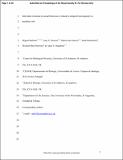Individual variation in reproductive behaviour is linked to temporal heterogeneity in predation risk
Abstract
Variation in predation risk is a major driver of ecological and evolutionary change, and, in turn, of geographical variation in behaviour. While predation risk is rarely constant in natural populations, the extent to which variation in predation risk shapes individual behaviour in wild populations remains unclear. Here, we investigated individual differences in reproductive behaviour in 16 Trinidadian guppy populations and related it to the observed variation in predator biomass each population experienced. Our results show that high heterogeneity in predator biomass is linked to individual behavioural diversification. Increased within-population heterogeneity in predator biomass is also associated with behavioural polymorphism. Some individuals adjust the frequency of consensual mating behaviour in response to differences in sex ratio context, while others display constantly at elevated frequencies. This pattern is analogous to a ‘live fast, die young’ pace-of-life syndrome. Notably, both high and low mean differences in predator biomass led to a homogenization of individual frequency of consensual mating displays. Overall, our results demonstrate that individual behavioural variation is associated with heterogeneity in predator biomass, but not necessarily with changes in mean values of predator biomass. We suggest that heterogeneity in predator biomass is an informative predictor of adaptive responses to changes in biotic conditions.
Citation
Barbosa , M , Deacon , A E , Janeiro Silva , M J , Ramnarine , I , Morrissey , M B & Magurran , A E 2018 , ' Individual variation in reproductive behaviour is linked to temporal heterogeneity in predation risk ' , Proceedings of the Royal Society B: Biological Sciences , vol. 285 , no. 1870 , 20171499 . https://doi.org/10.1098/rspb.2017.1499
Publication
Proceedings of the Royal Society B: Biological Sciences
Status
Peer reviewed
ISSN
0962-8452Type
Journal article
Collections
Items in the St Andrews Research Repository are protected by copyright, with all rights reserved, unless otherwise indicated.

